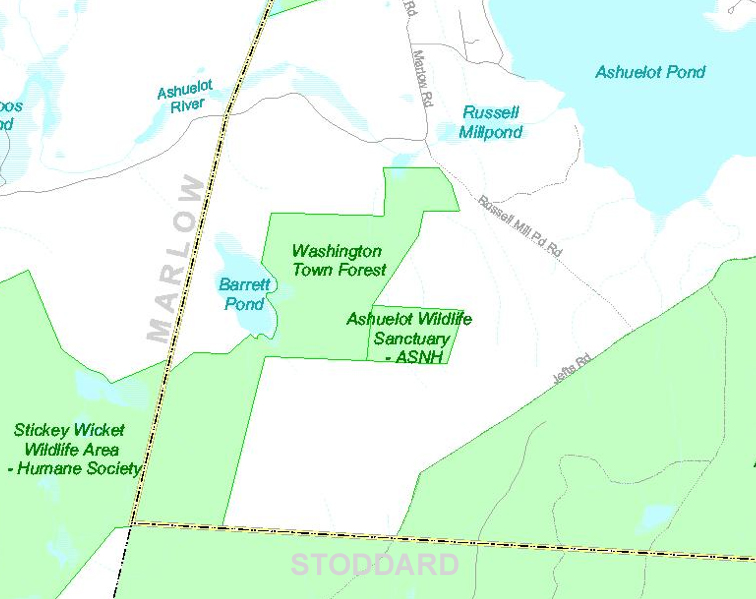|
The Barrett Pond property is the combination
of three adjoining tracts; Jeft's Lot in the south, the Barrett
Pond Lot in the middle, and the Russell Pond Lot in the north.
Together, they make up a deeded area of 191 acres. These lands
are important for the conservation of large tracts of open
space, as they connect three other conservation lands to each
other. To the west, in Marlow, is the 285 acre Orenda-Stickey
Wicket Wildlife Sanctuary. To the east is the 25-acre Ashuelot
Wildlife Sanctuary, belonging to the NH Audubon Society. To
the south, in both Stoddard and Washington, is the 11,000-acre
Andorra Forest. All told, a combined conservation area of
6,184 acres is being held together thanks to the Town of Washington's
Barrett Pond Property.

Barrett Pond has a variety of habitats for wildlife. Both
Barrett Pond and Russell Millpond offer excellent aquatic
habitats for amphibians, reptiles and warm water fishes. There
is a diversity of forest types and age classes, including
old fields with apple trees (used by many wildlife species).
Internal streams are also valuable, as are the rock outcrops
and boulder fields. Another important asset to wildlife is
that the "Jeft's Lot" section is wedged between two wildlife
sanctuaries.
There are five management units (MU's) on the Barrett Pond
property:
1) MU 1 is the largest forest type on the property, consisting
of one stand in each section. MU 1 is made up of scattered
white ashes, red maples, sugar maples and white birches of
small sawtimber size (12-16"), below which are more abundant
pole-sized trees of the same species. Most of the land burned
in the Marlow Fire is contained within MU 1. The bulk of MU
1 is found in the "Jeft's Lot" section, and is difficult to
operate due to slope and terrain restrictions.
2) MU 2 is a small pocket of scattered large sawtimber trees
with smaller poles below. The tree species are mostly sugar
maple, white ash and red maple, with occasional large yellow
birches as well. Most of the large trees have been scarred
by the Marlow Fire - some are now hollow as a result. The
terrain is both rocky and steep and would be very difficult
to operate in.
3) MU 3 makes up the southern half of the "Barrett Pond" section,
and is distinct in that it contains a sizable amount of red
spruce mixed with red maple and black cherry. Trees are mostly
pole-sized, with scattered larger stems of small and large
sawtimber diameters.
4) MU 4 is a small pocket of scattered mature white pine in
the center of the "Barrett Pond" section, below which are
pole-sized red maples and white birches. The western half
of this stand has a large number of dead, large white pines,
the cause of which is unknown.
5) MU 5 makes up the northern half of the "Barrett Pond" section,
and consists of a mixture of red oak, red maple and sugar
maple poles with occasional small sawtimber trees. Although
currently young, this is a valuable stand that deserves to
be cultivated. A large boulder field to the east will pose
some operating problems that must be worked around.
|

